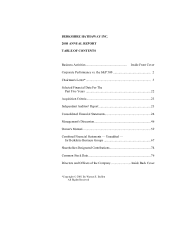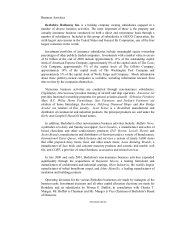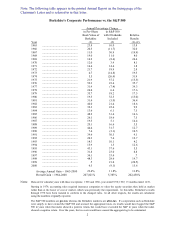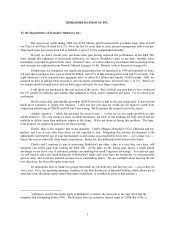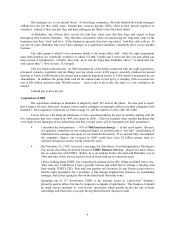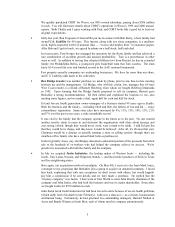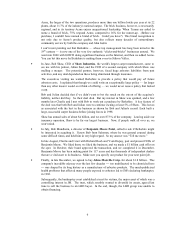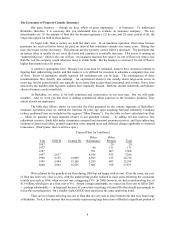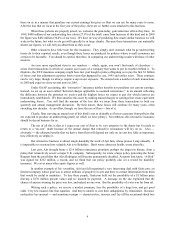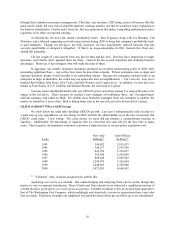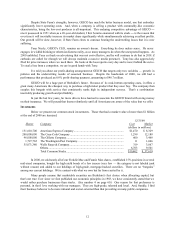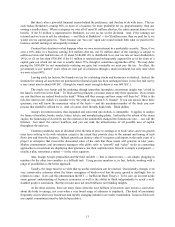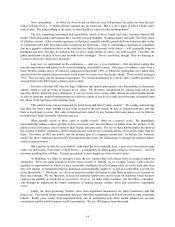Berkshire Hathaway 2000 Annual Report Download - page 5
Download and view the complete annual report
Please find page 5 of the 2000 Berkshire Hathaway annual report below. You can navigate through the pages in the report by either clicking on the pages listed below, or by using the keyword search tool below to find specific information within the annual report.4
Our managers are a very special breed. At most large companies, the truly talented divisional managers
seldom have the job they really want. Instead they yearn to become CEOs, either at their present employer or
elsewhere. Indeed, if they stay put, they and their colleagues are likely to feel they have failed.
At Berkshire, our all-stars have exactly the jobs they want, ones that they hope and expect to keep
throughout their business lifetimes. They therefore concentrate solely on maximizing the long-term value of the
businesses that they “own” and love. If the businesses succeed, they have succeeded. And they stick with us: In
our last 36 years, Berkshire has never had a manager of a significant subsidiary voluntarily leave to join another
business.
The other group to which I owe enormous thanks is the home-office staff. After the eight acquisitions
more than doubled our worldwide workforce to about 112,000, Charlie and I went soft last year and added one
more person at headquarters. (Charlie, bless him, never lets me forget Ben Franklin’s advice: “A small leak can
sink a great ship.”) Now we have 13.8 people.
This tiny band works miracles. In 2000 it handled all of the details connected with our eight acquisitions,
processed extensive regulatory and tax filings (our tax return covers 4,896 pages), smoothly produced an annual
meeting to which 25,000 tickets were issued, and accurately dispensed checks to 3,660 charities designated by our
shareholders. In addition, the group dealt with all the routine tasks served up by a company with a revenue run-
rate of $40 billion and more than 300,000 owners. And, to add to all of this, the other 12.8 are a delight to be
around.
I should pay to have my job.
Acquisitions of 2000
Our acquisition technique at Berkshire is simplicity itself: We answer the phone. I’m also glad to report
that it rings a bit more often now, because owners and/or managers increasingly wish to join their companies with
Berkshire. Our acquisition criteria are set forth on page 23, and the number to call is 402-346-1400.
Let me tell you a bit about the businesses we have purchased during the past 14 months, starting with the
two transactions that were initiated in 1999, but closed in 2000. (This list excludes some smaller purchases that
were made by the managers of our subsidiaries and that, in most cases, will be integrated into their operations.)
•I described the first purchase — 76% of MidAmerican Energy — in last year’s report. Because
of regulatory constraints on our voting privileges, we perform only a “one-line” consolidation of
MidAmerican’s earnings and equity in our financial statements. If we instead fully consolidated
the company’s figures, our revenues in 2000 would have been $5 billion greater than we
reported, though net income would remain the same.
•On November 23, 1999, I received a one-page fax from Bruce Cort that appended a Washington
Post article describing an aborted buyout of CORT Business Services. Despite his name, Bruce
has no connection with CORT. Rather, he is an airplane broker who had sold Berkshire a jet in
1986 and who, before the fax, had not been in touch with me for about ten years.
I knew nothing about CORT, but I immediately printed out its SEC filings and liked what I saw.
That same day I told Bruce I had a possible interest and asked him to arrange a meeting with
Paul Arnold, CORT’s CEO. Paul and I got together on November 29, and I knew at once that we
had the right ingredients for a purchase: a fine though unglamorous business, an outstanding
manager, and a price (going by that on the failed deal) that made sense.
Operating out of 117 showrooms, CORT is the national leader in “rent-to-rent” furniture,
primarily used in offices but also by temporary occupants of apartments. This business, it should
be noted, has no similarity to “rent-to-own” operations, which usually involve the sale of home
furnishings and electronics to people having limited income and poor credit.

